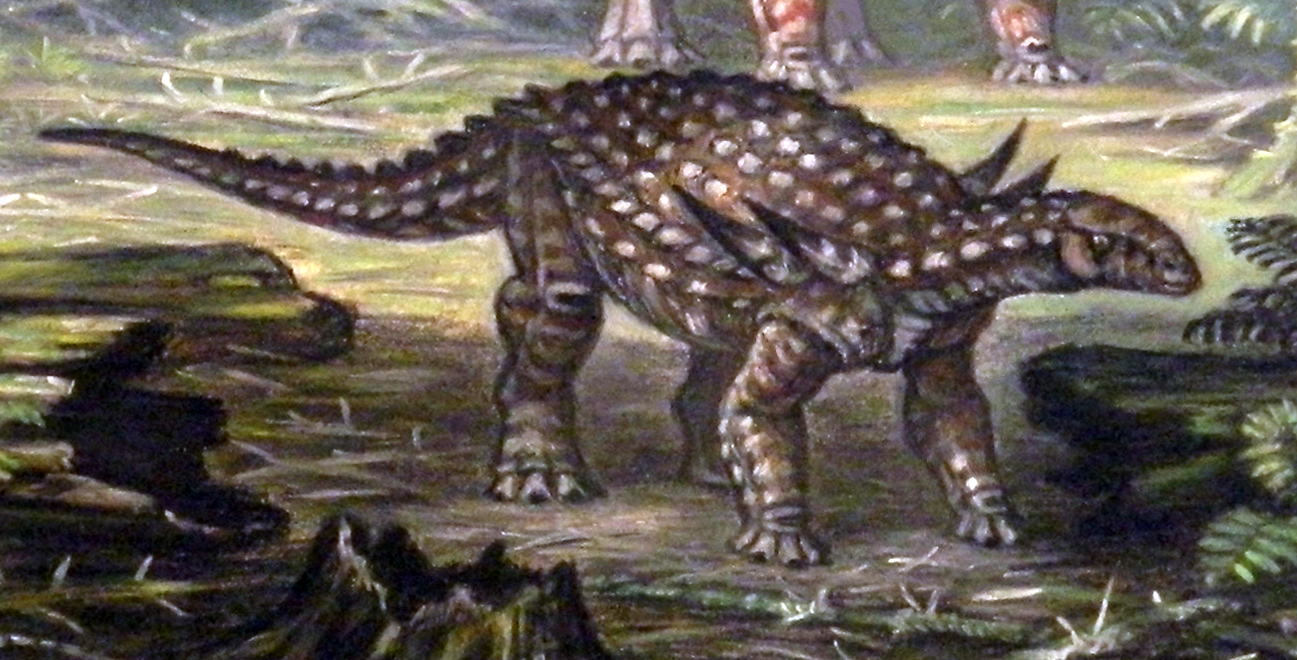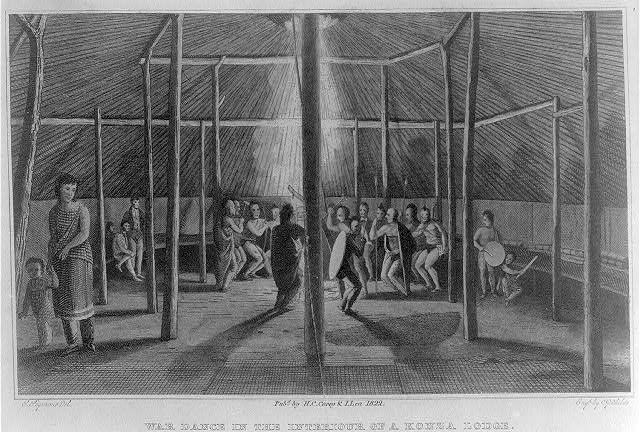|
Silvisaurus
''Silvisaurus'', from the Latin silva "woodland" and Greek sauros "lizard", is a nodosaurid ankylosaur from the Early to Late Cretaceous period. It is one of the only known dinosaur species named from Kansas and was designated the official state land fossil in 2023. Discovery and species A fossil of the species was discovered in the 1950s by rancher Warren W. Condray of Wells, Kansas. He notified senator Frank Carlson who directed him to the chancellor of the University of Kansas, Franklin David Murphy. Murphy sent the preparator of the paleontology of vertebrates department of the natural history museum of the university, Russell R. Camp, to investigate the matter. In July 1955 Camp, with help from Condray, recovered the skeleton of a dinosaur. It was further prepared by Camp and Glenn H. Marihugh. In 1960 the find was described and named by Theodore H. Eaton Jr., also from the University of Kansas, as the type species ''Silvisaurus condrayi''. The generic name is derived ... [...More Info...] [...Related Items...] OR: [Wikipedia] [Google] [Baidu] |
Silvisaurus Skull Fossil
''Silvisaurus'', from the Latin silva "woodland" and Greek sauros "lizard", is a nodosaurid ankylosaur from the Early to Late Cretaceous period. It is one of the only known dinosaur species named from Kansas and was designated the official state land fossil in 2023. Discovery and species A fossil of the species was discovered in the 1950s by rancher Warren W. Condray of Wells, Kansas. He notified senator Frank Carlson who directed him to the chancellor of the University of Kansas, Franklin David Murphy. Murphy sent the preparator of the paleontology of vertebrates department of the natural history museum of the university, Russell R. Camp, to investigate the matter. In July 1955 Camp, with help from Condray, recovered the skeleton of a dinosaur. It was further prepared by Camp and Glenn H. Marihugh. In 1960 the find was described and named by Theodore H. Eaton Jr., also from the University of Kansas, as the type species ''Silvisaurus condrayi''. The generic name is derived fr ... [...More Info...] [...Related Items...] OR: [Wikipedia] [Google] [Baidu] |
Nodosaurid
Nodosauridae is a family of ankylosaurian dinosaurs known from the Late Jurassic to the Late Cretaceous periods in what is now Asia, Europe, North America, and possibly South America. While traditionally regarded as a monophyletic clade as the sister taxon to the Ankylosauridae, some analyses recover it as a paraphyletic grade leading to the ankylosaurids. Description Nodosaurids, like their sister group the ankylosaurids, were heavily armored dinosaurs adorned with rows of bony armor nodules and spines (osteoderms), which were covered in keratin sheaths. Ankylosaurians were small- to large-sized, heavily built, quadrupedal, herbivorous dinosaurs, possessing small, leaf-shaped teeth. Unlike ankylosaurids, nodosaurids lacked mace-like tail clubs and instead had more flexible tail tips. Many nodosaurids had spikes projecting outward from their shoulders. One particularly well-preserved nodosaurid "mummy", the holotype of '' Borealopelta markmitchelli'', preserves a nearly complet ... [...More Info...] [...Related Items...] OR: [Wikipedia] [Google] [Baidu] |
Pawpawsaurus
''Pawpawsaurus'', meaning "Pawpaw Lizard", is a nodosaurid ankylosaur from the Cretaceous (late Albian) of Tarrant County, Texas, discovered in May 1992. The only species yet assigned to this taxon, ''Pawpawsaurus campbelli,'' is based on a complete skull (lacking mandibles) from the marine Paw Paw Formation (Wachita Group). Discovery ''Pawpawsaurus'' was found in the Paw Paw Formation in Tarrant County, Texas, in May 1992, by Cameron Campbell. A complete skull is the only specimen, from which the binomial was named ''Pawpawsaurus campbelli''. The Paw Paw Formation has produced another nodosaurid, '' Texasetes pleurohalio'' (Coombs, 1995), which may prove to be a senior synonym of ''Pawpawsaurus''. This is the only nodosaurid known to have possessed the bony eyelids commonly found in ankylosaurids. The skull of ''Pawpawsaurus'' bears some notable similarities to that of '' Silvisaurus'', such as the presence of teeth in the premaxilla and the restriction of the osseous seconda ... [...More Info...] [...Related Items...] OR: [Wikipedia] [Google] [Baidu] |
Sauropelta
''Sauropelta'' ( ; meaning 'lizard shield') is a genus of nodosaurid dinosaur that existed in the Early Cretaceous Period of North America. One species (''S. edwardsorum'') has been named. Anatomically, ''Sauropelta'' is one of the most well-understood nodosaurids, with fossilized remains recovered in the U.S. states of Wyoming, Montana, and possibly Utah. It is also the earliest known genus of nodosaurine; most of its remains are found in a section of the Cloverly Formation dated to 108.5 million years ago. It was a medium-sized nodosaurid, measuring about long. ''Sauropelta'' had a distinctively long tail which made up about half of its body length. Although its body was smaller than a modern black rhinoceros, ''Sauropelta'' was about the same mass, weighing in at about . The extra weight was largely due to its extensive covering of bony armor, including the characteristically large spines projecting from its neck. Description ''Sauropelta'' was a heavily built quadrupedal ... [...More Info...] [...Related Items...] OR: [Wikipedia] [Google] [Baidu] |
Dakota Formation
The Dakota is a sedimentary rock, sedimentary geologic unit name of Formation (stratigraphy), formation and Group (stratigraphy), group rank in Midwestern North America. The Dakota units are generally composed of sandstones, mudstones, clays, and shales deposited in the Mid-Cretaceous opening of the Western Interior Seaway.Monroe, James S. and Wicander, Reed (1997) ''The Changing Earth: Exploring Geology and Evolution'' (2nd edition) Wadsworth Publishing Company, Belmont, California, page 610, The usage of the name Dakota for this particular Albian-Cenomanian strata is exceptionally widespread; from British Columbia and Alberta to Montana and Wisconsin to Colorado and Kansas to Utah and Arizona. It is famous for producing massive colorful rock formations in the Rocky Mountains and the Great Plains of the United States, and for preserving both Fossil track, dinosaur footprints and early deciduous tree leaves. Owing to extensive weathering of older rocks during the Jurassic and Tri ... [...More Info...] [...Related Items...] OR: [Wikipedia] [Google] [Baidu] |
Kansas
Kansas ( ) is a landlocked U.S. state, state in the Midwestern United States, Midwestern region of the United States. It borders Nebraska to the north; Missouri to the east; Oklahoma to the south; and Colorado to the west. Kansas is named after the Kansas River, in turn named after the Kaw people, Kansa people. Its List of capitals in the United States, capital is Topeka, Kansas, Topeka, and its List of cities in Kansas, most populous city is Wichita, Kansas, Wichita; however, the largest urban area is the bi-state Kansas City metropolitan area split between Kansas and Missouri. For thousands of years, what is now Kansas was home to numerous and diverse Plains Indians, Indigenous tribes. The first settlement of non-indigenous people in Kansas occurred in 1827 at Fort Leavenworth. The pace of settlement accelerated in the 1850s, in the midst of political wars over the Slavery in the United States, slavery debate. When it was officially opened to settlement by the U.S. governm ... [...More Info...] [...Related Items...] OR: [Wikipedia] [Google] [Baidu] |
Secondary Palate
The secondary palate is an anatomical structure that divides the nasal cavity from the oral cavity in many vertebrates. In human embryology, it refers to that portion of the hard palate that is formed by the growth of the two palatine shelves medially and their mutual fusion in the midline. It forms the majority of the adult palate and meets the primary palate at the incisive foramen. Clinical significance Secondary palate development begins in the sixth week of pregnancy and can lead to cleft palate when development goes awry. There are three major mechanisms known to cause this failure: #Growth retardation — Palatal shelves do not grow enough to meet each other. #Mechanical obstruction — Improper mouth size, or abnormal anatomical structures in the embryonic mouth prevent fully grown shelves from meeting each other. #Midline epithelial dysfunction (MED) - The surface mucosa of embryonic shelves is impaired, which causes a failure of palatal fusion. Evolution T ... [...More Info...] [...Related Items...] OR: [Wikipedia] [Google] [Baidu] |
Cenomanian
The Cenomanian is, in the International Commission on Stratigraphy's (ICS) geological timescale, the oldest or earliest age (geology), age of the Late Cretaceous epoch (geology), Epoch or the lowest stage (stratigraphy), stage of the Upper Cretaceous series (stratigraphy), Series. An age is a unit of geochronology; it is a unit of time; the stage is a unit in the stratigraphic column deposited during the corresponding age. Both age and stage bear the same name. As a unit of geologic time measure, the Cenomanian Age spans the time between 100.5 and 93.9 million years ago (Mya). In the geologic timescale, it is preceded by the Albian and is followed by the Turonian. The Upper Cenomanian starts around at 95 Mya. The Cenomanian is coeval with the Woodbinian of the regional timescale of the Gulf of Mexico and the early part of the Eaglefordian of the regional timescale of the East Coast of the United States. At the end of the Cenomanian, an anoxic event took place, called the Cenomani ... [...More Info...] [...Related Items...] OR: [Wikipedia] [Google] [Baidu] |
Sacrum
The sacrum (: sacra or sacrums), in human anatomy, is a triangular bone at the base of the spine that forms by the fusing of the sacral vertebrae (S1S5) between ages 18 and 30. The sacrum situates at the upper, back part of the pelvic cavity, between the two wings of the pelvis. It forms joints with four other bones. The two projections at the sides of the sacrum are called the alae (wings), and articulate with the ilium at the L-shaped sacroiliac joints. The upper part of the sacrum connects with the last lumbar vertebra (L5), and its lower part with the coccyx (tailbone) via the sacral and coccygeal cornua. The sacrum has three different surfaces which are shaped to accommodate surrounding pelvic structures. Overall, it is concave (curved upon itself). The base of the sacrum, the broadest and uppermost part, is tilted forward as the sacral promontory internally. The central part is curved outward toward the posterior, allowing greater room for the pelvic cavity. In a ... [...More Info...] [...Related Items...] OR: [Wikipedia] [Google] [Baidu] |
Early Cretaceous
The Early Cretaceous (geochronology, geochronological name) or the Lower Cretaceous (chronostratigraphy, chronostratigraphic name) is the earlier or lower of the two major divisions of the Cretaceous. It is usually considered to stretch from 143.1 Megaannum#SI prefix multipliers, Ma to 100.5 Ma. Geology Proposals for the exact age of the Barremian–Aptian boundary ranged from 126 to 117 Ma until recently (as of 2019), but based on drillholes in Svalbard the defining Anoxic event#Cretaceous, early Aptian Oceanic Anoxic Event 1a (OAE1a) was dated to 123.1±0.3 Ma, limiting the possible range for the boundary to c. 122–121 Ma. There is a possible link between this anoxic event and a series of Early Cretaceous large igneous provinces (LIP). The Ontong Java Plateau, Ontong Java-Manihiki Plateau, Manihiki-Hikurangi Plateau, Hikurangi large igneous province, emplaced in the South Pacific at c. 120 Ma, is by far the largest LIP in Earth's history. The Onto ... [...More Info...] [...Related Items...] OR: [Wikipedia] [Google] [Baidu] |







